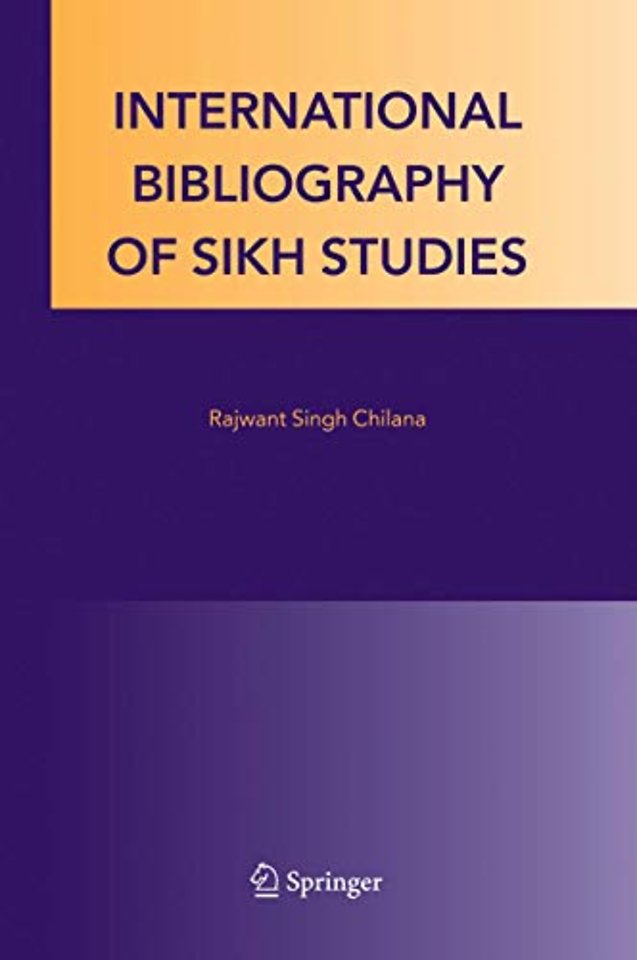International Bibliography of Sikh Studies
Samenvatting
Sikhism is one of the youngest religions of the world, and its followers, Sikhs, are renowned as ?erceandproudwarriors. Theybelieveinsingle,formlessGod,andarenowsettledinalmost- erycountryonthisplanet. Becauseoftheirdedication,hard-workandentrepreneurship,anumber of Sikh leaders have occupied coveted positions like President, Prime Minister, Home Minister, FinanceMinister,ForeignMinister,DefenceMinister,SpeakeroftheLokSabha,ChiefMinisters, Governors, Mayors, High Commissioners, Members of Parliament and Legislative Assemblies not only in India but also in other countries. Beside politics, Sikhs have also excelled in the ?eld of education and research, and have earned the distinction of becoming Vice-Chancellors, Directors, Professors, and Senior Research Scientists. Due to their growing popularity, people from around the world want to learn more about their culture, history, politics, religion, and traditions. In recent decades, several studies on Sikhs and Sikhism have attracted global attention. Many colleges and universities in India, Canada, Australia, United Kingdom, United States and other countries have introduced teaching and researchprogramsonSikhculture,religionandDiaspora. Severalconferencesandseminarshave beenorganizedatinternationallevelondifferentaspectsofSikhism. Thisgrowingawarenesshas resulted literature avalanche in Sikh studies. A large number of contributions have been made in the form of various publications. And most recently with the advancement in information technologies, there is a trend to develop more and more electronic and web resources on Sikhs and their religion. For the bibliographical control of the voluminous literature on Sikhism, some efforts have been made in the past by scholars and librarians like Ganda Singh, Kirpal Singh, N. Gerald Barrier, Hakam Singh, Jaginder Singh Ramdev, Jasmer Singh, Rajwant Singh, Man Singh Deora, Priya Muhar Rai, Darshan Singh Tatla, and others.
Specificaties
Inhoudsopgave
1. Printed and Electronic Reference Resources. 1.1 Printed Resources. 1.1.1. Encyclopaedias. 1.1.2. Indexing & Abstracting Sources. 1.1.3. Biographical Sources. 1.1.4. Geographical Sources. 1.1.5. Bibliographical Sources. 1.1.6. Dictionaries & Glossaries. 1.2. Electronic & Online Resources. 1.2.1. CD-ROMS. 1.2. 2. Online Resources. 1.2.2.1. Online Access to Guru Granth Sahib. 1.2.2.2. Online Books, Journals & Newspapers. 1.2.2.3. Sikh Studies in Universities & Colleges. 1.2.2.4. Sikh Diaspora.
2. Sikh Gurus. 2.1 Guru Nanak Dev. 2.1.1. Biography. 2.1.2. Janamsakhi. 2.1.3. Philosophy. 2.1.4. Poetry. 2.1.5. Teachings. 2.1.6. Travels. 2.1.7. Mardana. 2.2. Guru Angad Dev. 2.3. Guru Amar Das. 2.4. Guru Ram Das. 2.5. Guru Arjan Dev. 2.6. Guru Hargobind. 2.6.1. Miri Piri. 2.7. Guru Har Rai. 2.8. Guru Harkrishan. 2.9. Guru Tegh Bahadur. 2.9.1. Martyrdom. 2.9.2. Teachings. 2.9.3. Travels. 2.9.4. Relations with Aurangzeb. 2.10. Guru Gobind Singh. 2.10.1. Biography. 2.10.2. Philosophy. 2.10.3. Travels. 2.10.4. Teachings. 2.10.5. As Poet. 2.10.6. Mission. 2.10.7. Battles. 2.10.8. Relations with Mughal Emperors. 2.10.9. Five beloved. 2.10.10. Baptism.
3. Sikh Scriptures & Gurbani. 3.1. Gurbani. 3.2. Guru Granth Sahib. 3.3. Works of Guru Nanak. 3.3.1. Japuji. 3.3.2. Mul Mantra. 3.3.3. Asa di Var. 3.3.4. Barah Maha. 3.3.5. Siddha Gosht. 3.4. Works of Guru Amar Das. 3.4.1. Anand Sahib. 3.5. Works of Guru Arjan Dev. 3.5.1. Sukhmani. 3.6 Works of Guru Tegh Bahadur. 3.7. Works of Guru Gobind Singh. 3.7.1. Dasam Granth. 3.7.2. Japu Sahib. 3.7.3. Chandi di Var. 3.7.4. Bachitra Natak. 3.7.5. Akal Ustat. 3.7.6. Zafarnama & Fatehnama.
4. Bhagats and Saints. 4.1. Kabir. 4.2. Namdev. 4.4. Ravidas. 4.4. Sheikh Farid.
5. Sikh Philosophy.
6. Sikh History. 6.1. Banda Singh Bahadur. 6.2. SikhMisls. 6.2.1. Ramgarhia Misl. 6.3. Maharaja Ranjit Singh. 6.3.1. Family. 6.3.1.1. Maharaja Duleep Singh. 6.3.2. Court. 6.3.3. Military System. 6.3.4. Hari Singh Nalwa. 6.3.5. Battles. 6.3.6. Foreign Relations. 6.3.7. Kohinoor. 6.3.8. Epilogue. 6.4 Anglo Sikh Relations. 6.5. Anglo Sikh War. 6.6. Singh Sabha Movement. 6.7. Sikhs and Freedom Struggle. 6.8. Gurdwara Reform Movement. 6.8.1. All India Sikh Gurdwara Act & Legislation. 6.9. Akali Movement. 6.10. Punjabi Suba Movement.
7. Sikh Politics. 7.1. Akal Takht. 7.2. Central Sikh League. 7.3. Akali Dal. 7.4. Shiromani Gurdwara Prabandhak Committee. 7.5. Chief Khalsa Diwan. 7.6. Khalistan Movement.
8. Sikh Leaders. 8.1. Jassa Singh Ahluwalia. 8.2. Kapur Singh. 8.3. Baba Kharak Singh. 8.4. Master Tara Singh. 8.5. Sant Fateh Singh. 8.6. Sant Harchand Singh Longowal. 8.7. Giani Zail Singh. 8.8. Dr. Manmohan Singh.
9. Sikh Art & Architecture.
10. Sikh Coins (Numismatics).
11. Sikh Culture & Traditions. 11.1. Baisakhi.
12. Sikhs as Khalsa.
13. Sikh Code of Conduct, Institutions & Ceremonies. 13.1. Code of Conduct. 13.1.1. Nitnem. 13.1.2. Rehras. 13.1.3. Ardas. 13.1.4. Sangat (Congregation). 13.1.5. Nam Simran (Meditation). 13.1.6. Langar (Community Kitchen). 13.2. Institutions. 13.2.1. Hukamnama. 13.2.2 Gurmata. 13.2. 3. Sarbat Khalsa. 13.3. Ceremonies. 13.3.1. Birth & Death. 13.3.2 Initiation. 13.3.3. Naming ceremony. 13.3.4. Marriage ceremony.
14. Sikh Symbols & Identity. 14.1. Sikh Identity. 14.2. Hair (Kesh). 14.3. Turban. 14.4. Kirpan (Sword).
15. Sikh Education & Research.
16. Sikh Scholars & Personalities. 16.1. Bhai Gurdas. 16.2. Bhai Vir Singh. 16.2.1. Poetical Works. 16.2.2. Rana Surat Singh. 16.2.3. Prose. 16.2.4. As an historian. 16.2.5. Appraisal. 16.2.6. Tributes. 16.3. Dr. Balbir Singh. 16.4. Puran Singh. 16.5.

